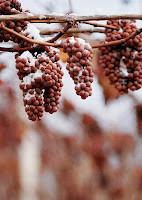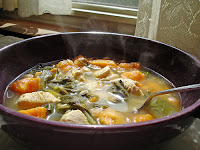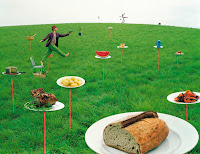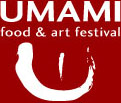
I adore dessert wines. I don't know where this love came from but as of late, I can't get my fill. Having gone through ports, muscats, and then lingering for a bit on a personal favorite of mine, Vin Santo Chianti Classico Reserva, I have now discovered ice wines. Though some of you wine connoisseurs may be familiar with these wonderful dessert aperitifs, more and more occasional wine enthusiasts are now discovering these exceptional wines.
Ice wine, or Eiswein, originated in Franconia, Germany in 1794. Grapes were left on the vines until the first deep frost, and the freeze/thaw cycles that occurred concentrated both the sugars and flavors of the grapes. The process was refined and now ice wines are highly prized produced in Germany, Austria and Canada. The Niagara region of Ontario, Canada is currently the most widely respected producer of ice wines in the world.
 |
| Franconia, Germany |
Ice wine is a type of dessert wine produced from grapes that have been frozen while still on the vine. The sugars and other dissolved solids do not freeze, but the water does, allowing a more concentrated grape
must to be pressed from the frozen grapes which results in a smaller amount of more concentrated, very sweet wine. With ice wines, the freezing happens before the fermentation, not afterwards. Unlike the grapes from which other dessert wines, such as Sauternes, Tokaji, or Trockenbeerenauslese, are made, ice wine grapes should not be affected by Botrytis cinerea or noble rot, at least not to any great degree. Only healthy grapes keep in good shape until the opportunity arises for an ice wine harvest, which in extreme cases can occur after the New Year, on a northern hemisphere calendar. This gives ice wine its characteristic refreshing sweetness balanced by high acidity. When the grapes are free of Botrytis, they are said to come in "clean." Due to the labor-intense and risky production process resulting in relatively small amounts of wine, ice wines are generally quite expensive. This chart shows how sugar varies with the temperature:
Temperature ~ Sugar Content
- -6°C 29%
- -7°C 33%
- -8°C 36%
- -9°C 39%
- -10°C 43%
- -11°C 46%
- -12°C 49%
- -13°C 52%
- -14°C 56%
As in all harvests, the exact moment of harvest is extremely important for ice wine. Ideally, the temperature should get to
-10°C to -13°C before picking. By waiting till this perfect moment, the grape achieves the optimum level of sugar and flavor. They are then carefully picked by hand. Grapes in this condition have a very low yield; often an entire vine only makes a single bottle and this is typically why ice wine can be so expensive, often sold in half-bottles only.
Ice wine is typically made of Vidal and Riesling grapes. After this long harvest process, the grapes go through weeks of fermentation, followed by a few months of barrel aging. The wine ends up a golden color, or a deep, rich amber and has a very sweet taste. The flavor is a combination of apricot, peach, mango, melon or other sweet fruits with a nutty aroma. It is usually enjoyed as a dessert wine, chilled for one or two hours and served in small cordial glasses.
Ice Wine History
There are indications that frozen grapes were used to make wine as early as Roman times. Pliny the Elder (AD 23 - 79) wrote about certain grape varieties that they were not harvested before frost had occurred. The poet Martial (AD 40 - 102) recommended that grapes should be left on the vine until November or until they were stiff with frost.
 |
| Pliny the Elder |
Pliny the Elder
Details as to the wine-making and description of these wines are unknown. It can not be completely ruled out that the descriptions refer to dried grape wines, a common style of wine in Roman times, where the raisin-like grapes were harvested late enough for the first frost to have fallen. In either case, the method seems later to have been forgotten.
It is believed that the first post-Roman ice wine was made in Franconia in Germany in 1794. Better documentation exists for an ice wine harvest in Dromersheim close to Bingen in Rheinhessen on February 11, 1830. The grapes were of the 1829 vintage. That winter was harsh and some wine-growers had the idea to leave grapes hanging on the vine for use as animal fodder. When it was noticed that these grapes yielded very sweet must, they were pressed and an ice wine was produced. It should be noted that sweet wines produced from late harvested grapes were well-established as the most valued German wine style by the early 19th century, following the discovery of Spätlese at Schloss Johannisberg in Rheingau in 1775, and the subsequent introduction of the Auslese designation. These wines would usually be produced from grapes affected by noble rot. Thus, Eiswein is a more recent German wine style than the botrytised wines.
 |
| Schloss Johannisberg |
Throughout the 19th century and until 1960, Eiswein harvests were a rare occurrence in Germany. Only six 19th century vintages with Eiswein harvests have been documented, including 1858, the first Eiswein at Schloss Johannisberg. There seems to have been little effort to systematically produce these wines during this period, and their production was probably the rare result of freak weather conditions. It was the invention of the pneumatic bladder press which made the production of ice wine practical and led to a substantial increase in the frequency and Schloss Johannisberg quantities of production. 1961 saw the production of a number of German ice wines and the wine increased in popularity in the following years. The production has also been assisted by other technological inventions in the form of electrical lighting driven by portable generators (to assist harvest in the cold hours of morning darkness, before the grapes thaw) and plastic films that are used for "packaging" the vines in order to protect the ripe grapes from being eaten by birds while the wine-grower waits for frost.
 |
| Karl Kaiser |
The pioneer status of the winery Inniskillin in Niagara-on-the-Lake, Ontario led to their first ice wine, produced in 1984 under the direction of the winery's Austrian-born co-owner Karl Kaiser, often being mentioned as Canada's first ice wine. However, ice wine was produced in the Okanagan Valley of British Columbia by German immigrant Walter Hainle in 1972. This ice wine was the result of an early and unexpected frost and yielded 40 litres of wine, which Hainle originally did not intend to sell, although he did so in 1978. In 1983, Karl Kaiser and Inniskillin's German neighbor Ewald Reif, as well as two wineries with Austrian winemakers located in another part of Ontario, Hillebrand and Pelee Island, all left grapes on their vines in order to try to produce ice wine. Inniskillin and Reif lost their entire crop to hungry birds, while Hillebrand and Pelee Island were able to harvest a minuscule amount of frozen grapes. In 1984, Kaiser used nets to protect his vines and was able to produce Inniskillin's first ice wine. This wine was made from Vidal grapes and was in fact labelled "Eiswein".

After the ice wine production was set on commercial footing, Canadian ice wine quickly became popular with domestic consumers and reviewers and many other Canadian producers picked up the idea, since the harsh Canadian winters lend themselves well to the large-scale production. The international breakthrough of Canadian ice wine came in 1991, when Inniskillin's 1989 Vidal ice wine won the Grand Prix d’Honneur at Vinexpo. The Canadian trend towards increased cultivation of Vitis vinifera (European) grape varieties in the 1990s expanded the palette of varieties available to be bitten by frost. By the early 2000s, Canada was established as the largest producer of ice wine in the world.
In Germany in the early 2000s, good ice wine vintages have been more rare than throughout the 1980s and 1990s. Many wine-growers cite climate change as a cause and this received support from a study by the Geisenheim Institute.
 |
| Riesling |
Ice Wine Grapes
Typical grapes used for ice wine production are Riesling, considered to be the most noble variety by German winemakers; Vidal, highly popular in British Columbia and Ontario, Canada; and, interestingly, the red grape Cabernet Franc. Many vintners, especially from the New World, are experimenting with making ice wine from other varieties: whites such as Seyval Blanc, Chardonnay, Kerner, Gewürztraminer, Chenin Blanc, Pinot Blanc, and Ehrenfelser; or reds such as Merlot, Pinot Noir, and even Cabernet Sauvignon. Pillitteri Estates Winery from the Niagara-on-the-Lake region of Ontario claim to be the first winery in the world producing Shiraz (Syrah) ice wine with the 2004 vintage. Ice wines from white varieties tend to be pale
 |
| Vidal |
yellow or light gold in color when they are young and can maderise (acquiring a deep amber-golden color) as they age. The red varieties tend to have a light burgundy or even pink color like that of rosé wines.Some vintners in Canada have taken a step forward in experimenting with sparkling ice wine. Sparkling ice wines have texture similar to other sparkling wines, such as champagne or Asti, but with fuller body, and a significantly higher sugar level balanced with high acidity.
Ice Wine Production
Natural ice wines require a hard freeze (by law in Canada 17 °F or colder, and in Germany 19 °F or colder), to occur sometime after the grapes are ripe, which means that the grapes may hang on the vine for several months following the normal

harvest. If a freeze does not come quickly enough, the grapes may rot and the crop will be lost. If the freeze is too severe, no juice can be extracted. Vineland Winery in Ontario once broke their pneumatic press in the 1990s while pressing the frozen grapes because they were too hard. The longer the harvest is delayed, the more fruit will be lost to wild animals and dropped fruit. Since the fruit must be pressed while it is still frozen, pickers often must work at night or very early in the morning, harvesting the
grapes within a few hours, while cellar workers must work in unheated spaces.

In Austria, Germany, and Canada, the grapes must freeze naturally to be called ice wine. In other countries, some winemakers use cryoextraction (that is, mechanical freezing) to simulate the effect of a frost and typically do not leave the grapes to hang for extended periods as is done with natural ice wines. These non-traditional ice wines are sometimes referred to as "icebox wines". An example is Bonny Doon's Vin de Glacière. The high sugar level in the must leads to a slower-than-normal fermentation. It may take months to complete the fermentation (compared to days or weeks for regular wines) and special strains of yeasts should be used.
My Selections
Egon Muller, Riesling, Eiswein, Mosel-Saar-Ruwer, Scharzhofberger, 1996: Deep golden colored, this full bodied Eiswine has a nearly ideal combination between hyper-sweetness and refreshing acidity, along with lemon-lime, citrus peel and minerals. A long spicy finish that cannot help but enchant. One meant for early drinking or medium term cellaring, the wine should cellar comfortably until 2020.
 Krebs-Grode, Eiswein, Auxerrois, Eiswein Rheinhessen, 1998
Krebs-Grode, Eiswein, Auxerrois, Eiswein Rheinhessen, 1998: Medium bodied, with abundant spices on a deliciously sweet background of pineapples, lime and apricots and with generous hints of sweet cream and minerals, this superbly balanced and remarkably elegant wine has flavors that linger seemingly without end. Best drinking now - 2012.
Inniskillin, Ice Wine, 2001: Traditional ice wine, easily comparable to the best of Germany, this deeply sweet, but remarkably well balanced and elegant wine almost attacks you with luxurious flavors of peaches, lychees, pears in the way of fruits and then honey, cinnamon and candied fruits on the long finish. Full bodied,

with just the right amount of natural acidity, the wine is drinking nicely even now.
Inniskillin, Ice Wine, Vidal, 1999: This full bodied, bronzed orange wine is showing smooth and rich with honey and apple sweetness, together with aromas and flavors of dried apricots, yellow peaches and mangoes, Which overlay comfortably by light cinnamon-ginger flavors. Long and mouth-filling, the wine is drinking beautifully now and promises to cellar well until 2010 - 2012.
 Columbia Crest, Semillon Ice Wine, Reserve, 1998:
Columbia Crest, Semillon Ice Wine, Reserve, 1998: Full bodied, with intense honeyed sweetness and with delicious fig and summer fruits matched nicely by mocha and spiced roasted nut flavors and aromas. Excellent balance between fruits, sweetness and acidity and a very long finish add enormously to the charm of the wine. Drink 2002 - 2012 or longer.
Tasting
Even though it is normal for residual sugar content in ice wine to run from 180 g/L up to as high as 320 g/L, ice wine is very refreshing (as opposed to cloying) due to high acidity. Ice wine usually has a medium to full body, with a long lingering finish. The nose is usually reminiscent of peach, pear, dried apricot, honey, citrus, figs, caramel, green apple, etc., depending on the varietal. The aroma of tropical and exotic fruits such as pineapple, mango, or lychee is quite common, especially on white varietals.

Ice wine usually has a slightly lower alcohol content than regular table wine with some Riesling ice wines from Germany having an alcohol content as low as 6%. Ice wines produced in Canada usually have higher alcohol content, between eight and 13 percent. In most years, ice wines from Canada generally have higher brix degree (must weight) compared to those from Germany. This is largely due to the more consistent winters in Canada. Must with insufficient brix level cannot be made into ice wine, and is thus often sold as "special select late harvest" or "select late harvest" at a fraction of the price that true ice wine commands.
Connoisseurs argue about whether ice wine improves with age or is meant to be drunk young. Those who support aging claim that ice wine's very high sugar level (which is often much higher than that of Sauternes) and high acidity preserve the content for many years after bottling. Those who disagree contend that as ice wine ages, it loses its distinctive acidity, fruitiness, aroma, and freshness.
Since I'm just a simple lover of ice wines, I'll concentrate on the drinking and leave the arguing to the so called 'experts.' What I am hopeful of is that once you try a quality ice wine, especially if it's after reading this article, you raise a toast to me.
Bon Appetit!
Lou
edenwine.co.uk, longviewwinery.com, trentobike.org, spicetrader.net, Wolfgang Shultz, inniskillin, gvstudios.com, wineandpassionaccessories.com, lancette-arts.journal.ca, cookinglight.com, wikipedia.org
 ahead, usually the staples; bread, milk, eggs etc., but, when it comes to menu planning for the week, they let inspiration guide. This would describe me. I start in the produce aisle, then to the fish and meat departments immediately after that, finding myself visualizing the plates as I then go from aisle to aisle. I can spend hours learning about new products, quality checking, or just creating new ideas right there while I'm shopping. I like to allow the things I find on sale, or the specials, inspire me as to what may be my menu for the week. Remember, you don't always have to stick to what’s on your list. Enter into the shopping experience with a very open mind and be prepared to find substitutions for the food you may have predetermined for dinner. This is how the experience can become fun. Get the family involved with you as well, bring the kids along and make it a challenge to prepare the best meal yet! It will ultimately take the stress off of you (well maybe not the 'taking the kids with you' part of it) and make the ever so irritating question of "What’s for dinner?" disappear.
ahead, usually the staples; bread, milk, eggs etc., but, when it comes to menu planning for the week, they let inspiration guide. This would describe me. I start in the produce aisle, then to the fish and meat departments immediately after that, finding myself visualizing the plates as I then go from aisle to aisle. I can spend hours learning about new products, quality checking, or just creating new ideas right there while I'm shopping. I like to allow the things I find on sale, or the specials, inspire me as to what may be my menu for the week. Remember, you don't always have to stick to what’s on your list. Enter into the shopping experience with a very open mind and be prepared to find substitutions for the food you may have predetermined for dinner. This is how the experience can become fun. Get the family involved with you as well, bring the kids along and make it a challenge to prepare the best meal yet! It will ultimately take the stress off of you (well maybe not the 'taking the kids with you' part of it) and make the ever so irritating question of "What’s for dinner?" disappear.






















































